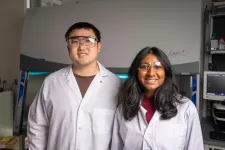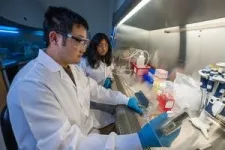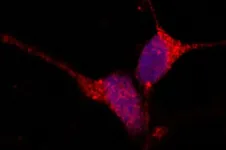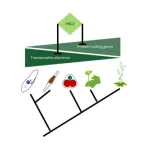(Press-News.org) HOUSTON – (Sept. 21, 2023) – To make a gene-editing tool more precise and easier to control, Rice University engineers split it into two pieces that only come back together when a third small molecule is added.
Researchers in the lab of chemical and biomolecular engineer Xue Sherry Gao created a CRISPR-based gene editor designed to target adenine ⎯ one of the four main DNA building blocks ⎯ that remains inactive when disassembled but kicks into gear once the binding molecule is added.
Compared to the intact original, the split editor is more precise and stays active for a narrower window of time, which is important for avoiding off-target edits. Moreover, the activating small molecule used to bind the two pieces of the tool together is already being used as an anticancer and immunosuppressive drug.
According to a study published in Nature Communications, the tool developed by Gao and collaborators performed well both in human cell cultures and in living mice, where it accurately edited a single base pair on a target gene. Given that single base-pair mutations ¾ also known as point mutations ⎯ are responsible for thousands of diseases, the split editor could have broad therapeutic applications.
“This tool has the potential to correct nearly half of the disease-causing point mutations in our genome,” said Hongzhi Zeng, the lead author of the study and a graduate student in the Gao lab. “However, current adenine base editors are in a constant ‘on’ state, which could lead to unwanted genome changes alongside the desired correction in the host genome.
“Our team set out to create a much improved version that can be turned on or off as needed, providing an unparalleled level of safety and accuracy.”
To install an ‘on/off’ switch, the researchers broke the adenine base editor into two separate proteins that remain inactive until sirolimus (previously known as rapamycin) is added ⎯ a molecule discovered in 1972 in soil bacteria on Easter Island that is approved by the U.S. Food and Drug Administration for use in cancer therapies and other medical procedures.
“Upon introduction of this small molecule, the two separate inactive fragments of the adenine base editor are glued together and rendered active,” Zeng said. “As the body metabolizes the rapamycin, the two fragments disjoin, deactivating the system.”
The researchers found some additional benefits to splitting the gene editor in two.
“Compared to an intact editor, our version reduces overall off-target edits by over 70% and increases the accuracy of on-target edits,” Zeng said.
In collaboration with Zheng Sun, associate professor in the Department of Molecular and Cellular Biology and in the endocrinology, diabetes and metabolism division of the Department of Medicine at Baylor College of Medicine, researchers targeted the PCSK9 gene, which serves as the blueprint for a protein that helps regulate blood cholesterol levels.
“We hope to see the eventual application of our split genome-editing tool with higher precision to address human health-related questions in a much safer way,” said Gao, the Ted N. Law Assistant Professor of Chemical and Biomolecular Engineering.
The research was supported by the National Science Foundation (CBET-2143626), the Robert A. Welch Foundation (C-1952), the National Institutes of Health (HL157714, DK111436, AG069966), the Dan L. Duncan Comprehensive Cancer Center (P30CA125123), the National Cancer Institute Specialized Programs of Research Excellence (P50CA126752), the Gulf Coast Center for Precision Environmental Health (P30ES030285) and the Texas Medical Center Digestive Diseases Center (P30DK056338).
-30-
This release can be found online at news.rice.edu.
Follow Rice News and Media Relations via Twitter @RiceUNews.
Peer-reviewed paper:
“A split and inducible adenine base editor for precise in vivo base editing” | Nature Communications | DOI: 10.1038/s41467-023-41331-5
Authors: Hongzhi Zeng, Qichen Yuan, Fei Peng, Dacheng Ma, Ananya Lingineni, Kelly Chee, Peretz Gilberd, Emmanuel Osikpa, Zheng Sun and Xue Gao
https://doi.org/10.1038/s41467-023-41331-5
Image downloads:
https://news-network.rice.edu/news/files/2023/09/230911_Gao-Lab_Gustavo-09009.jpg
CAPTION: Hongzhi Zeng (left) and Ananya Lingineni (Photo by Gustavo Raskosky/Rice University)
https://news-network.rice.edu/news/files/2023/09/230911_Gao-Lab_Gustavo-08953.jpg
CAPTION: Hongzhi Zeng (left) and Ananya Lingineni (Photo by Gustavo Raskosky/Rice University)
Related stories:
Rice scientists reengineer cancer drugs to be more versatile:
https://news.rice.edu/news/2023/rice-scientists-reengineer-cancer-drugs-be-more-versatile
New enzyme could mean better drugs:
https://news.rice.edu/news/2023/new-enzyme-could-mean-better-drugs
Rice University scientists get fungi to spill their secrets:
https://news.rice.edu/news/2023/rice-university-scientists-get-fungi-spill-their-secrets
Zeng places second in Base Editing Enzymes and Applications poster contest:
https://chbe.rice.edu/news/zeng-places-second-base-editing-enzymes-and-applications-poster-contes
Xue Sherry Gao wins CAREER Award:
https://news.rice.edu/news/2022/xue-sherry-gao-wins-career-award
RNA-editing tool a fast, sensitive test for COVID-19:
https://news.rice.edu/news/2022/rna-editing-tool-fast-sensitive-test-covid-19
Links:
The Gao Laboratory: xuegaolab.org
Department of Chemical and Biomolecular Engineering: https://chbe.rice.edu/
Department of Chemistry: https://chemistry.rice.edu/
BioScience Research Collaborative: https://brc.rice.edu/
George R. Brown School of Engineering: https://engineering.rice.edu
Located on a 300-acre forested campus in Houston, Rice University is consistently ranked among the nation’s top 20 universities by U.S. News & World Report. Rice has highly respected schools of Architecture, Business, Continuing Studies, Engineering, Humanities, Music, Natural Sciences and Social Sciences and is home to the Baker Institute for Public Policy. With 4,552 undergraduates and 3,998 graduate students, Rice’s undergraduate student-to-faculty ratio is just under 6-to-1. Its residential college system builds close-knit communities and lifelong friendships, just one reason why Rice is ranked No. 1 for lots of race/class interaction and No. 4 for quality of life by the Princeton Review. Rice is also rated as a best value among private universities by Kiplinger’s Personal Finance.
END
Split gene-editing tool offers greater precision
Rice lab engineers adenine base editor with enhanced control
2023-09-21
ELSE PRESS RELEASES FROM THIS DATE:
Diamond materials as solar-powered electrodes - spectroscopy shows what's important
2023-09-21
It sounds like magic: photoelectrodes could convert the greenhouse gas CO2 back into methanol or N2 molecules into valuable fertiliser - using only the energy of sunlight. An HZB study has now shown that diamond materials are in principle suitable for such photoelectrodes. By combining X-ray spectroscopic techniques at BESSY II with other measurement methods, Tristan Petit's team has succeeded for the first time in precisely tracking which processes are excited by light as well as the crucial role of the surface of the diamond materials.
At first glance, lab-grown diamond materials ...
How do toxic proteins accumulate in Alzheimer’s and other diseases?
2023-09-21
Under normal circumstances, tau protein is part of the brain’s infrastructure, important for stabilizing neurons into their proper shapes. But sometimes tau gets knotted up into tangles and turns toxic, injuring brain tissue and causing tauopathies, a group of brain diseases characterized by problems with learning, memory and movement. Alzheimer’s disease is the most common tauopathy, but the group also includes Parkinson’s disease, chronic traumatic encephalopathy (CTE) and several rare genetic conditions.
In search of ways to prevent these destructive ...
Study details immune cells vital to success of vaccines against coronavirus
2023-09-21
A study has revealed new details about a key population of immune system cells critical to successful vaccination against the pandemic virus, SARS-CoV-2.
Led by researchers at NYU Grossman School of Medicine and New York Genome Center, the current study focused on T cells, which along with B cells, compose the human immune system’s response to invading viruses and bacteria. A subset of T cells, labeled with the surface protein CD8, produce molecules that directly kill infected cells. B cells produce antibody proteins that neutralize and label infected cells for removal from the body.
Without risking ...
University of Cincinnati research examines the molecular mechanism of psychological loss
2023-09-21
Psychological loss can occur when someone loses a job, loses a sense of control or safety or when a spouse dies. Such loss, which erodes well-being and negatively impacts quality of life, may be a common experience but little is known about the molecular process in the brain that occurs because of loss.
New research from the University of Cincinnati explores those mechanisms through a process known as enrichment removal (ER). The study highlights an area of the brain that plays a key role in psychological loss and identifies new molecular targets that may alleviate its impact.
The research was published in the journal Molecular Psychiatry.
The research was led by Marissa Smail, a ...
Cardiff University chooses Figshare as integral part of research data management strategy
2023-09-21
Digital Science, a technology company serving stakeholders across the research ecosystem, is pleased to announce that Cardiff University has chosen Figshare from Digital Science’s flagship products to enhance its researcher support services, as it continues its work as a leading research institution.
Cardiff University – already excelling in the production of high-quality, innovative research that translates into benefits for the city, Wales and worldwide – has signed a two-year deal to utilize Figshare as its data repository and to form an integral ...
MD Anderson Research Highlights for September 21, 2023
2023-09-21
HOUSTON ― The University of Texas MD Anderson Cancer Center’s Research Highlights showcases the latest breakthroughs in cancer care, research and prevention. These advances are made possible through seamless collaboration between MD Anderson’s world-leading clinicians and scientists, bringing discoveries from the lab to the clinic and back.
Understanding the role of exceptional research as a driving force behind progress in its mission to end cancer, MD Anderson is proud to support World Cancer Research Day, Sept. 24, which calls for global efforts to promote cancer ...
Incidence of diabetes among youth before and during the pandemic
2023-09-21
About The Study: In this study that included data from Kaiser Permanente Southern California of individuals age 19 and younger, the incidence of type 1 diabetes slightly increased overall and type 2 diabetes significantly increased after the beginning of the COVID-19 pandemic, in particular among non-Hispanic Black and Hispanic youth. These findings suggest the need for further evaluation of physiologic and behavioral risk factors preceding new-onset diabetes during the pandemic.
Authors: Matthew T. Mefford, Ph.D., of Kaiser Permanente Southern ...
Disparities in emergency medicine residents’ performance assessments by race, ethnicity, and sex
2023-09-21
About The Study: This analysis of assessments of 2,708 emergency medicine residents found evidence of sex-specific ethnoracial disparities in ratings on the Milestones assessments. These disparities increased over time across multiple Milestones assessments and were most severe for female residents of ethnoracial groups that are underrepresented in medicine.
Authors: Elle Lett, Ph.D., M.A., M.Biostat., of the University of Washington School of Public Health in Seattle, is the corresponding author.
To ...
New origin story for key regulatory gene
2023-09-21
Polycomb repressive complex 2 (PRC2) was discovered decades ago in Drosophila, where it was found to be a key controller of developmental genes. Further analyses showed that PRC2 modifies chromatin and silences target gene expression. However, the ancestral function of PRC2 - as functioning primarily to control genes during development - was called into question when researchers discovered that PRC2 also plays a role in unicellular species, in which no development takes place. A first hint at PRC2’s original role came from studies in red algae, which found PRC2 left its methylation mark on transposons – jumping genes that ...
Ultrathin films achieve record hydrogen-nitrogen separation
2023-09-21
Metal-organic frameworks (MOFs) are a class of materials that contain nano-sized pores. These pores give MOFs record-breaking internal surface areas, which make them extremely versatile for a number of applications: separating petrochemicals and gases, mimicking DNA, producing hydrogen, and removing heavy metals, fluoride anions, and even gold from water are just a few examples.
In the gas-separation domain, MOFs are particularly interesting for separating hydrogen from nitrogen, which is crucial for clean energy production, fuel cell efficiency, ammonia synthesis, and various ...
LAST 30 PRESS RELEASES:
University of Oklahoma researcher awarded funding to pursue AI-powered material design
Exploring how the visual system recovers following injury
Support for parents with infants at pediatric check-ups leads to better reading and math skills in elementary school
Kids’ behavioral health is a growing share of family health costs
Day & night: Cancer disrupts the brain’s natural rhythm
COVID-19 vaccination significantly reduces risk to pregnant women and baby
The role of vaccination in maternal and perinatal outcomes associated with COVID-19 in pregnancy
Mayo Clinic smartwatch system helps parents shorten and defuse children's severe tantrums early
Behavioral health spending spikes to 40% of all children’s health expenditures, nearly doubling in a decade
Digital cognitive behavioral treatment for generalized anxiety disorder
Expenditures for pediatric behavioral health care over time and estimated family financial burden
Air conditioning in nursing homes and mortality during extreme heat
The Alps to lose a record number of glaciers in the next decade
What makes a good proton conductor?
New science reporting guide published for journalists in Bulgaria
New international study reveals major survival gaps among children with cancer
New science reporting guide published for journalists in Turkey
Scientists develop a smarter mRNA therapy that knows which cells to target
Neuroanatomy-informed brain–machine hybrid intelligence for robust acoustic target detection
Eight SwRI hydrogen projects funded by ENERGYWERX
The Lundquist Institute and its start-up company Vitalex Biosciences Announces Strategic Advancement of Second-Generation fungal Vaccine VXV-01 through Phase 1 Trials under $40 Million Competitive Con
Fine particles in pollution are associated with early signs of autoimmune disease
Review article | Towards a Global Ground-Based Earth Observatory (GGBEO): Leveraging existing systems and networks
Penn and UMich create world’s smallest programmable, autonomous robots
Cleveland researchers launch first major study to address ‘hidden performance killer’ in athletes
To connect across politics, try saying what you oppose
Modulating key interaction prevents virus from entering cells
Project explores barriers to NHS career progression facing international medical graduates
Jeonbuk National University researchers explore the impact of different seasonings on the flavor perception of Doenjang soup
Two Keck Medicine of USC Hospitals named Leapfrog Top Teaching Hospitals
[Press-News.org] Split gene-editing tool offers greater precisionRice lab engineers adenine base editor with enhanced control






